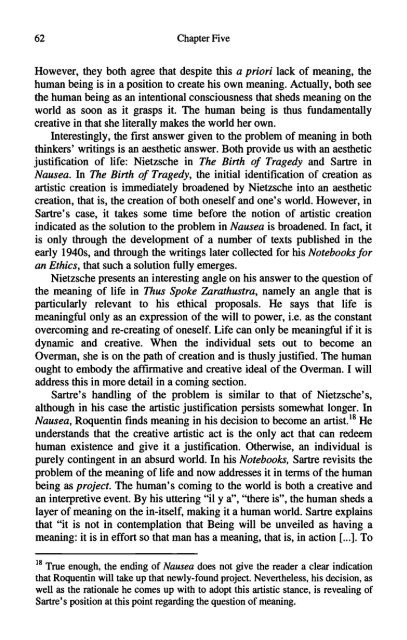Sartre's second century
Sartre's second century
Sartre's second century
Create successful ePaper yourself
Turn your PDF publications into a flip-book with our unique Google optimized e-Paper software.
62 Chapter Five<br />
However, they both agree that despite this a priori lack of meaning, the<br />
human being is in a position to create his own meaning. Actually, both see<br />
the human being as an intentional consciousness that sheds meaning on the<br />
world as soon as it grasps it. The human being is thus fundamentally<br />
creative in that she literally makes the world her own.<br />
Interestingly, the first answer given to the problem of meaning in both<br />
thinkers' writings is an aesthetic answer. Both provide us with an aesthetic<br />
justification of life: Nietzsche in The Birth of Tragedy and Sartre in<br />
Nausea. In The Birth of Tragedy, the initial identification of creation as<br />
artistic creation is immediately broadened by Nietzsche into an aesthetic<br />
creation, that is, the creation of both oneself and one's world. However, in<br />
<strong>Sartre's</strong> case, it takes some time before the notion of artistic creation<br />
indicated as the solution to the problem in Nausea is broadened. In fact, it<br />
is only through the development of a number of texts published in the<br />
early 1940s, and through the writings later collected for his Notebooks for<br />
an Ethics, that such a solution fully emerges.<br />
Nietzsche presents an interesting angle on his answer to the question of<br />
the meaning of life in Thus Spoke Zarathustra, namely an angle that is<br />
particularly relevant to his ethical proposals. He says that life is<br />
meaningful only as an expression of the will to power, i.e. as the constant<br />
overcoming and re-creating of oneself. Life can only be meaningful if it is<br />
dynamic and creative. When the individual sets out to become an<br />
Overman, she is on the path of creation and is thusly justified. The human<br />
ought to embody the affirmative and creative ideal of the Overman. I will<br />
address this in more detail in a coming section.<br />
<strong>Sartre's</strong> handling of the problem is similar to that of Nietzsche's,<br />
although in his case the artistic justification persists somewhat longer. In<br />
Nausea, Roquentin finds meaning in his decision to become an artist. 18 He<br />
understands that the creative artistic act is the only act that can redeem<br />
human existence and give it a justification. Otherwise, an individual is<br />
purely contingent in an absurd world. In his Notebooks, Sartre revisits the<br />
problem of the meaning of life and now addresses it in terms of the human<br />
being as project. The human's coming to the world is both a creative and<br />
an interpretive event. By his uttering "il y a", "there is", the human sheds a<br />
layer of meaning on the in-itself, making it a human world. Sartre explains<br />
that "it is not in contemplation that Being will be unveiled as having a<br />
meaning: it is in effort so that man has a meaning, that is, in action [...]. To<br />
True enough, the ending of Nausea does not give the reader a clear indication<br />
that Roquentin will take up that newly-found project. Nevertheless, his decision, as<br />
well as the rationale he comes up with to adopt this artistic stance, is revealing of<br />
<strong>Sartre's</strong> position at this point regarding the question of meaning.
















